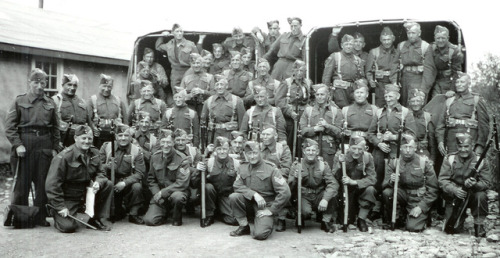historicalfirearms:Veterans Guard of CanadaWhile it is fairly well known that Britain raised its Hom
historicalfirearms:Veterans Guard of CanadaWhile it is fairly well known that Britain raised its Home Guard in May 1940, its less well known that Canada also formed a version of the Home Guard, the Veterans Guard of Canada.Also formed in May 1940, the Veterans Guard, initially called the Veteran’s Home Guard, was made up predominantly from men who had served during the First World War. Many of them, now in their 40s or older, were too old to be called up as regulars. But with valuable military experience the Canadian government felt the old soldiers could be used to free up younger troops for the front line. The Veterans Guard were not raised to help defend against invasion as the British Home Guard was. Instead, they were used to guard important industrial sites and infrastructure, such as factories, bridges, dams and railways, against potential saboteurs. Another important role was the guarding of enemy prisoners of war. Members of the Veteran’s Guard drilling with Mk3 Ross rifles (source)As prison guards a detachment of the Guard were involved in a two day prison uprising, known as the Battle of Bowmanville, in Ontario in October 1942. One member of the Veterans Guard suffered a fractured skull in the melee before Canadian Commando cadets ended the stand off with tear gas and hoses. The Guard were issued battle dress and received a unique Cap Badge as well as a shoulder tab saying ‘Veterans Guard’. The men were predominantly armed with a variety of rifles including SMLEs as well as surplus Pattern 14s and Canadian Ross Rifles.At its peak over 17,000 men served in the Guard, split between part time and full time companies. These roughly 250 men were formed in regions across Canada. While the part time Veterans Guard units acted as local militia, the full time - active companies were moved to locations were troops were needed. At peak strength, in June 1943, the active companies boasted 451 officers and 9,806 other ranks. Some active companies even served overseas. As the tide of the war turned and the threat of sabotage and invasion waned some companies were disbanded and after the end of the war as POWs returned home more units were steadily disbanded with the last standing down in 1947.Sources:Images: 1 2 3‘Veterans Guard of Canada’, POWs in Canada, (source)‘Veterans Guard of Canada‘, Canada at War, (source)If you enjoy the content please consider supporting Historical Firearms through Patreon! -- source link
Tumblr Blog : www.historicalfirearms.info


